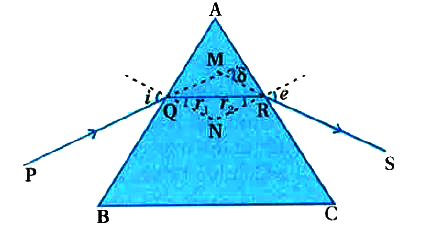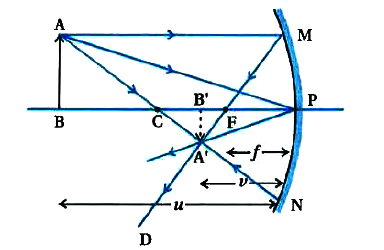Obtain the relation between incidence angle, emergence angle, prism angle and deviation angle for refraction through prismSolution in Gujrati
In figure the cross-section perpendicular to the rectangular surface of a prism made up of a transparent medium is shown.

A ray of monochromatic light is incident at point Q on the AB surface of the prism.
According to Snell.s Law, it is refracted and travels along path QR. It experiences deviation δ1, at point Q.
Ray QR is incident on surface AC at point R and suffering deviation δ2, due to refraction emerges in the direction RS.
If the incident ray PQ is extended it advances in QE direction. When the emergent ray RS is extended backwards it meets PE in D.
Incidence angle : Angle made by incident ray at a point on surface with normal is called incidence angle.
∠PQK=i
Refracted angle : Angle made by refracted ray at a point on surface with normal is called refracted angle. ∠RQL=r1, and ∠QRL=r2
Emergence angle : Angle made by emergent ray with normal of surface is called emergence angle.
∠TRS = e
Angle of Deviation : “Angle between incident ray and emergent ray is called angle of deviation (δ)”.
∠εDS=δ
In the figure in □AQLR,
∠AQL=90∘ and ∠ARL=90∘ are right angle.
∴∠A+∠QLR=180∘ ... (1)
Now, in △QLR
r1+r2+∠QLR=180∘ ...(2)
From equation (1) and (2),
r1+r2+∠QLR=∠A+∠QLR=180∘
∴r1+r2=∠A ... (3)
From the geometry of the figure angle of deviation δ is the exterior angle for ∠DQRi.e.∠EDS=∠DOR
∴∠EDS=∠DQR+∠DRQ
∴δ=δ1+δ2
but, ∠DQR=∠DQL–∠RQL
δ1=i−r1 [∵∠PQK=∠DQL=i]
and,∠DRQ=∠DRL−∠QRL
δ2=e−r2
[∵∠DRL=∠TRS=e]
So, equation (4)
δ=i−r1+e−r2
δ=i+e−(r1+r2)
∴δ=i+e−A [∵ equation (3)]
∴i+e=A+δ
This equation gives the relation between angle of deviation, angle of incident, angle of emergence and angle of prism.
From above equation we say that angle of deviation depends on the angle of incidence.
Topper's Solved these Questions
- BOOK - KUMAR PRAKASHANCHAPTER - RAY OPTICS AND OPTICAL INSTRUMENTSEXERCISE - SECTION - A (TRY YOURSELF)74videos
RAY OPTICS AND OPTICAL INSTRUMENTS
- BOOK - KUMAR PRAKASHANCHAPTER - RAY OPTICS AND OPTICAL INSTRUMENTSEXERCISE - SECTION-B (NUMERICALS)(NUMERICAL FROM TEXTUAL ILLUSTRATIONS)17videos
RAY OPTICS AND OPTICAL INSTRUMENTS
- BOOK - KUMAR PRAKASHANCHAPTER - MOVING CHARGES AND MAGNETISMEXERCISE - SECTION D (MCQs ASKED IN COMPETITIVE EXAMS)34videos
MOVING CHARGES AND MAGNETISM
- BOOK - KUMAR PRAKASHANCHAPTER - SAMPLE QUESTION PAPER EXERCISE - PART-B SECTION-C5videos
SAMPLE QUESTION PAPER
Similar Questions
Give range of wavelength of visible light.
02:41View SolutionSuppose that the lower half of the concave mirror.s reflecting surface as shown in figure is covered with an opaque (non-reflective) material. What effect will this have on the image of an object placed in front of the mirror ?
 01:48View Solution
01:48View SolutionElectric charge Q having mass M moves on a circular path of radius R with velocity →v, perpendicular to uniform magnetic field B. When a particle completes one revolution, work done by the field is _______
09:21View SolutionTwo charges –q and +q are located at points (0, 0, –a) and (0, 0, a), respectively.
(a) What is the electrostatic potential at the points (0, 0, z) and (x, y, 0) ?
(b) Obtain the dependence of potential on the distance r of a point from the origin when r/a>>1 .
(c) How much work is done in moving a small test charge from the point (5,0,0) to (–7,0,0) along the x-axis? Does the answer change if the path of the test charge between the same points is not along the x-axis?01:57View SolutionIf A is angle of prism, D is angle of deviation, i is angle of incidence and e angle of emergence,then what is the correct relation between them ?
02:49View SolutionIn the minimum deviation position of a prism how are angle of incidence and angle of emergence related ?
10:49View Solution(a) If the refracting angle of a prism is 60^@ and the minimum deviation is 30^@ , then find the angle of incidence. (b) A ray of light passes through an equilateral prism such that the angle of emergence is equal to the angle of incidence and each is equal to 3//4^(th) of the angle of prism. Find the angle of deviation. (c) The refracting of a prism is A and the refractive index of the material of the prism is cotA//2 . Find the angle of deviation. (d) The angle of a prism is 60^@ . What is the angle of incidence for minimum deviation? The refractive index of the material of the prism is sqrt2 .
02:32View SolutionA ray of light passes through the equilateral prism such that angle of incidence is equal to the angle of emergence if the angle of incidence is 45∘. The angle of deviation will be
View SolutionIn an isosceles prism of prism angle 45^(@) , it is found that when the angle of incidence is same as the prism angle, the emergent ray grazes the emergent surface. Find the refractive index of the material of the prism.For what angle of incidence the angle of deviation will be minimum ?
02:40View Solution(a) Draw a ray diagram showing the passage of light through a glass prism. Hence obtain a relation between the angles of deviation, incidence and emergence and angle of prism.
(b) Show that no ray can pass through a prism whose refracting angle A is greater than twice the critical angle for the material of the prism.02:29View Solutionन्यूनतम विचलन कोण, प्रिज्म कोण तथा आपतन कोण में संबन्ध लिखिये।
01:56View SolutionA light ray passes through a prism of angle A in a position of minimum deviation. Obtain and expression for (a) the angle of incidence in terms of the angle of the prism and the angle of minimum deviation (b) the angle of refraction in terms of the refractive index of the prism.
06:37View SolutionWhat is the relation between angle of prism (A), angle of deviation (d), angle of incident (i1) and angle of emergence (i2) ?
03:08View SolutionThe refractive index of a prism is √2 and its refractive angle is 60∘ . If a ray emerge with the minimum angle of deviation then the angle of incidence will be
07:04View SolutionWrite the relation between angle of prism, angle of incidence and angle of emergence.
01:12View Solution

